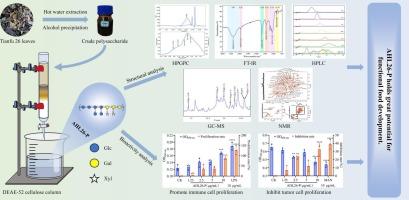Structure identification and in vitro immunomodulatory activities of polysaccharide AHL26-P from Arachis hypogaea (Tianfu 26) leaves
IF 4.2
Q2 CHEMISTRY, MULTIDISCIPLINARY
引用次数: 0
Abstract
Peanut leaves, an underutilized agricultural by-product of peanut cultivation, represent a sustainable source of bioactive polysaccharides. In this study, a novel polysaccharide (AHL26-P) was obtained from peanut leaves of Tianfu 26. The chemical structure and biological activities of AHL26-P was elucidated, with emphasis on its immunomodulatory and anti-tumor effects. The results showed that AHL26-P had a heavy average molecular weight (Mw) of 8476 Da. The backbone of AHL26-P consisted of (1 → 4)-Glcp, (1 → 3,6)-Glcp, (1 → 4,6)-Glcp, (1 → 2,6)-Galp, (1 → 6)-β-D-Galp, and four branched chains were terminated by two →2)-α-D-Glcp and two →1)-α-D-Xylp, respectively. Immunoreactivity studies revealed that the proliferation rates of B, T, and RAW 264.7 cells treated with 10 μg/mL of AHL26-P were 79.72 %, 49.36 %, and 86.00 %, respectively. The results of anti-tumor assay revealed that AHL26-P could directly inhibit the proliferation of Mouse Forestomach Carcinoma cell (MFC) and ascites tumor (S180). These results enriched the theoretical research system of peanut leaf polysaccharide and provided a foundation for developing functional foods with immune-enhancing properties.

天府花生叶多糖AHL26-P的结构鉴定及体外免疫调节活性
花生叶是花生种植中未充分利用的农业副产品,是生物活性多糖的可持续来源。本研究从天府26号花生叶片中提取了一种新的多糖AHL26-P。阐明了AHL26-P的化学结构和生物活性,重点阐述了其免疫调节和抗肿瘤作用。结果表明,AHL26-P的平均分子量为8476 Da。AHL26-P的主链由(1→4)-Glcp、(1→3,6)-Glcp、(1→4,6)-Glcp、(1→2,6)-Galp、(1→6)-β-D-Galp组成,其中4条支链分别由2→2)-α-D-Glcp和2→1)-α-D-Xylp终止。免疫反应性研究显示,10 μg/mL AHL26-P对B、T和RAW 264.7细胞的增殖率分别为79.72%、49.36%和86.00%。抗肿瘤实验结果显示,AHL26-P能直接抑制小鼠前胃癌细胞(MFC)和腹水肿瘤(S180)的增殖。这些结果丰富了花生叶多糖的理论研究体系,为开发具有免疫增强特性的功能食品提供了基础。
本文章由计算机程序翻译,如有差异,请以英文原文为准。
求助全文
约1分钟内获得全文
求助全文

 求助内容:
求助内容: 应助结果提醒方式:
应助结果提醒方式:


